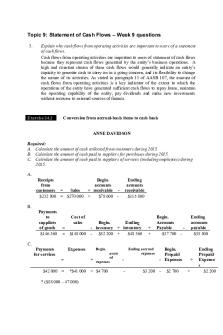Corporate Fundraising [ Topic 9] PDF
![Corporate Fundraising [ Topic 9]](https://pdfedu.com/img/crop/300x450/dl2zmqv0ey3v.jpg)
| Title | Corporate Fundraising [ Topic 9] |
|---|---|
| Course | Law of Associations |
| Institution | Western Sydney University |
| Pages | 2 |
| File Size | 102.9 KB |
| File Type | |
| Total Downloads | 74 |
| Total Views | 144 |
Summary
Download Corporate Fundraising [ Topic 9] PDF
Description
[TOPIC 9] CORPORATE FUNDRAISING CROWDSOURCE FUNDING OVERVIEW CROWD SOURCED FUNDING (CSF or CROWD FUNDING) - refers to raising funds (usually in small amounts) from a large number of individual investors. o E.g. Kickstarter, GoFundMe, Patreon o Generally, seen as donation funding Investors typically hope to receive some form of benefit (e.g. early access) but do not typically aspire to make a profit from the investment. ASIC do not review the course source funding offer documents CROWD-SOURCED EQUITY FUNDING This form of CSF is different in that it involves the issues of shares, usually up to a limited value, to a large group of investors. Investors who acquire shares therefore ‘members’ of the company and have rights under the CA o Chapter 6D has a long range of exceptions to the prospectus requirements (S 708), however, these cannot offer the same spread of investors as crowdfunding Challenges for fundraising: o Limits of maximum shareholders for proprietary companies (no more than 50 non-employee shareholders: s 113) o Although, both proprietary and public companies could use exceptions to prospectus requirements in Ch 6D these do not lend themselves to the CSF campaigns due to the limits on particular exceptions (such as the small-scale capital raising exception in s 708(1)-(8) or due to compliance costs involved in verifying that particular exceptions could apply. Typically undertake through online platforms, which in Australian are required to be licensed by ASIC CS equity requires investors apply for shared through licensed platforms, which places the platform operator in a gatekeeper role: s 738Q CROWD FUNDING FOR PUBLIC COMPANIES Pt 6D.3A - removed CSF from requirements of Ch 6D in favour of a specific regime for CSF in Pt 6D.3A REQUIREMENTS: o Eligible CSF company: s 738H
1
o
o
o
o o o
¡ Only unlisted public companies are classified as eligible CSF companies whose substantial purpose was investing in securities or interests in other entities or schemes (s 738H) CSF offer: s 738B ¡ Requires the release of a CSF offer document (published on the platform of a single CSF intermediary, which prescribed content ¡ Offer can only remain open for a maximum of 3 months: s 738N ¡ Can only cover fully paid ordinary shares in the company The CSF offer has to be made through a CSF intermediary: s 738C ¡ The CSF intermediary who has to have an Australian Financial Services License that authorised them to provide a CSF service CSP offer is subject to a cap of $5 million (including all CSF offer by the company and related parties within 12 months and all small-scale capital raising by the company and its related within 12 months before the CSF offer: s 738G Cap of no more than $25 million in gross assets and $25 million in consolidated annual revenue for the company making the CSF offer and all related parties: s738H(2) ONLY one CSF offer could be open at any one time by the company making the CSF offer and all of its related parties: s 738R Civil and criminal liability could be imposed for defective CSF offer documents, including on
the CSF intermediary but only where they had knowledge of the defect before posting the CSF on their platform: s 738Y o 5-day cooling off period for retail investors: s 738ZD CROWD FUNDING FOR PROPRIETARY COMPANIES Legislation under Pt6D.3A now include proprietary companies and removed the limited governance concessions granted under 2017 amendments S 738H: In addition, the amendments require proprietary companies that wish to access the CSF regime to: o Maintain at least two directors; o Prepare annual financial and directors’ reports in compliance with accounting standards; o Have their financial reports audited once they raise $3 million or more from CSF offers; and o Comply with the existing related party transaction rules in Ch 2E.
2...
Similar Free PDFs
![Corporate Fundraising [ Topic 9]](https://pdfedu.com/img/crop/172x258/dl2zmqv0ey3v.jpg)
Corporate Fundraising [ Topic 9]
- 2 Pages

Corporate Governance topic
- 8 Pages

Topic 9
- 5 Pages

Topic 9 Strict Liability
- 5 Pages

Summary-Notes-Fundraising
- 9 Pages

A Corporate Management Case 9
- 8 Pages

SW 353. - Fundraising Assignment
- 5 Pages

Topic 9 Week 9 Web Version
- 2 Pages

Topic 9 Ch10 Solution - sol
- 9 Pages
Popular Institutions
- Tinajero National High School - Annex
- Politeknik Caltex Riau
- Yokohama City University
- SGT University
- University of Al-Qadisiyah
- Divine Word College of Vigan
- Techniek College Rotterdam
- Universidade de Santiago
- Universiti Teknologi MARA Cawangan Johor Kampus Pasir Gudang
- Poltekkes Kemenkes Yogyakarta
- Baguio City National High School
- Colegio san marcos
- preparatoria uno
- Centro de Bachillerato Tecnológico Industrial y de Servicios No. 107
- Dalian Maritime University
- Quang Trung Secondary School
- Colegio Tecnológico en Informática
- Corporación Regional de Educación Superior
- Grupo CEDVA
- Dar Al Uloom University
- Centro de Estudios Preuniversitarios de la Universidad Nacional de Ingeniería
- 上智大学
- Aakash International School, Nuna Majara
- San Felipe Neri Catholic School
- Kang Chiao International School - New Taipei City
- Misamis Occidental National High School
- Institución Educativa Escuela Normal Juan Ladrilleros
- Kolehiyo ng Pantukan
- Batanes State College
- Instituto Continental
- Sekolah Menengah Kejuruan Kesehatan Kaltara (Tarakan)
- Colegio de La Inmaculada Concepcion - Cebu






